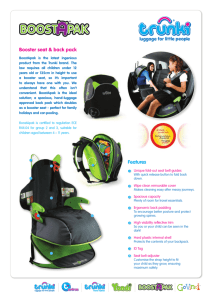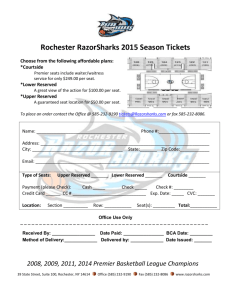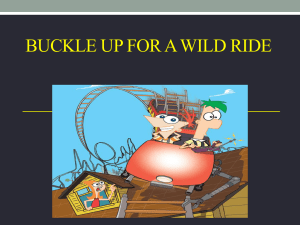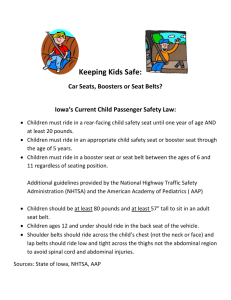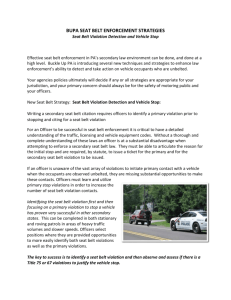Child Restraint Law Enforcement Worksheet
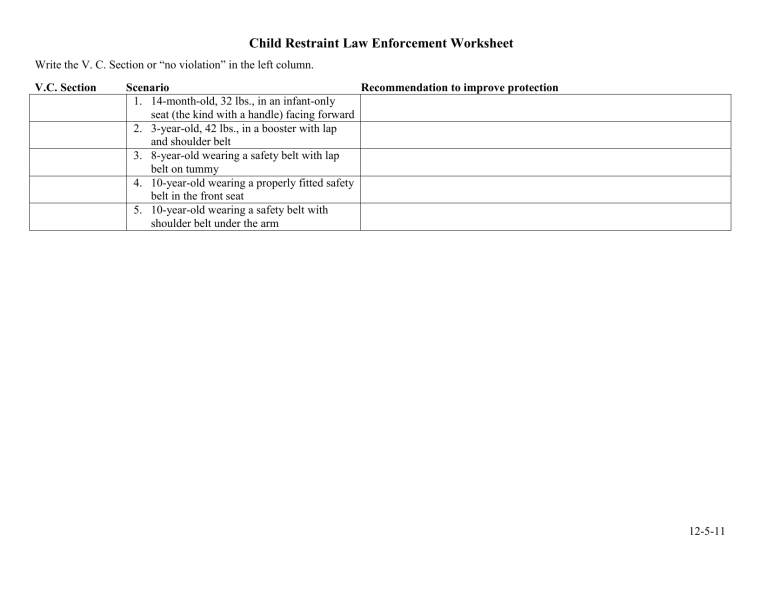
Child Restraint Law Enforcement Worksheet
Write the V. C. Section or “no violation” in the left column.
V.C. Section Scenario
1.
14-month-old, 32 lbs., in an infant-only seat (the kind with a handle) facing forward
Recommendation to improve protection
2.
3-year-old, 42 lbs., in a booster with lap and shoulder belt
3.
8-year-old wearing a safety belt with lap belt on tummy
4.
10-year-old wearing a properly fitted safety belt in the front seat
5.
10-year-old wearing a safety belt with shoulder belt under the arm
12-5-11
Enforcing California Restraint Laws for Children
Why Enforcement Is Important
Traffic collisions are still the number one cause of death and permanent injury of children.
According to the CHP, 80% of the kids under age 4 killed in California would have survived if they had been properly buckled up in a safety seat.
Studies show that strong enforcement increases compliance and reduces injuries.
These citations are “movers” (violations count one point on the driving record).
Answers to Common Questions Asked by Law Enforcement Officers
Q — Who is covered by the law?
A — It is unlawful for any driver to transport a child under 16 in a passenger vehicle or truck (any motor vehicle other than a motorcycle or bus) without the protection of a properly used restraint system.
Q — When is a child restraint required?
A — Children must ride in a properly secured child restraint system (safety seat, booster, or other certified product, such as a crash-tested car bed or harness) until they are at least 8 years old. Exceptions: A child under age 8 who is at least 4'9" may be transported in a safety belt if it is used properly. Children who weigh more than 40 lbs. may be transported in just a lap belt if the back seat of the vehicle was not equipped at the time of manufacture with combination lap and shoulder belts. In an emergency vehicle or in case of a life-threatening emergency, a child under 8 years may be secured with a vehicle safety belt if there is no safety seat available.
Physical unfitness, medical condition, or size may be cause for exemption, as determined by the court. There are no exemptions for taxis or vehicles registered out of state. Under no circumstances may a child be transported unrestrained.
Q — When is a child required to ride in the back seat?
A — Children are required to ride in the back seat until they are at least 8 years old. Exceptions: No forwardfacing rear seat in vehicle; child restraint cannot be properly installed in rear seat; all rear seats are occupied by other children age 7 or under; medical reasons. A child in a rear-facing child restraint may not ride in front if there is an active passenger air bag.
Q — What is a booster seat and when is it legal for a child to use one?
A — A booster seat is a firm cushion, with or without a backrest, that positions the lap and shoulder belt on the child. Depending on the model, boosters fit children from 30-40 lbs. up to 80-125 lbs. Some manufacturers require a minimum age of 3 or 4. The driver or parent may be cited for misuse if the child is under the minimum age or weight specified on the label or if a booster is used with just a lap belt. Booster seats were designed for children who have outgrown regular safety seats, so parents should be encouraged to keep the child in a seat with a harness as long as it fits.
Q — When is it legal for a child to wear just a vehicle safety belt?
A —Although a child who is age 8 or more is not specifically required to ride in a booster, the law requires proper use of safety belts. Most children are not tall enough until about age 10-12 for vehicle belts to fit properly without a booster. Examples of improper and dangerous use: shoulder belt under the arm or behind the back, lap belt on the tummy instead of the upper thighs.
Q — Which Vehicle Code Sections should be used when children are not properly restrained?
A — If the child is under age 8, use 27360 (a) for the parent or, if the parent is not present, for the driver. If the child is at least age 8 but under 16, use 27360.5 (a) for the parent or for the driver. If the parent is in the car, the driver is not cited. Do not use 27315 for children under age 16. (Note: 27360 (b) and 27360.5 (b) are no longer used for non-parent drivers.)
#99 Pg. 1 of 3 (2-23-13)
Q — V.C. Sections 27360 specifies that child restraints must be used “properly.” How is proper use defined?
A — Proper use is defined by the vehicle owner’s manual and child restraint manufacturer instruction booklet.
Here are some examples of visible, improper use which are prohibited by all manufacturers. A citation or warning may be issued for these dangerous practices:
√ Child riding unrestrained or sharing belt
√ Child under age 8 riding in front seat
√ Infant facing front of car
√ Rear-facing child in front of active air bag
√ Harness loose or not on shoulders
√ Safety seat loose (can be pulled more than 1”)
√ Shoulder belt under arm or behind back
Q — How can an officer who has no specialized training in child passenger safety determine if there is a violation?
A — Concentrate on the obvious, easily seen violations, such as kids in the front seat, toddlers standing up and moving around, or children riding in the cargo area of a vehicle. These situations are not only easy to spot, but also extremely dangerous for the children.
Q — Is it legal to ride in the back of a pickup under a camper shell? What about extra passengers in a vehicle when all of the belts are already in use?
A — No. All occupants must be properly restrained (no restraints that meet federal standards are available for the cargo area of a truck). The driver may be cited for violating the child restraint law and/or safety belt law, depending on the age of the unrestrained occupants.
Q — How much is the fine? May it be waived?
A — The fine for violating V.C. Section 27360 or 27360.5 is $100 plus penalty assessments, which adds up to more than $500. A first offense under this section may be reduced or waived by the court if the defendant shows economic disadvantage. If the fine is reduced, the court is mandated to require the violator to attend an education program. The fine for a second or subsequent offense is $250 plus penalty assessments.
Q — What can parents do if they believe they cannot afford to buy a safety seat?
A — Most California counties have programs to help people obtain inexpensive safety seats, and officers can provide the number of a local group that might help. The fine money collected for child restraint violations goes to local health departments to help them provide community education and safety seats for low-income families. A safety seat costs about as much as one tank of gas and much less than a baby crib or a playpen.
Whether a child comes from an affluent family or a poor one, he or she deserves to be protected from preventable death and injury.
Other laws and information about kids and cars
Health and Safety Code 118948(a) Smoking restriction
Smoking in a vehicle is prohibited if a child under 18 is present. Consequences: The fine is $100 plus penalty assessments
V.C. 15620 (a) Unattended Children in Vehicles
No person may leave a child age 6 or younger in a vehicle if the health or safety of the child is at risk, the engine is running, or the keys are in the ignition. The child must be supervised by a person at least age 12.
Insurance Code 11580.011 Replacing Child Restraints Used in a Crash
Auto insurance companies are required to ask whether a child restraint was in the vehicle in a covered crash. If a child was in the restraint or if it was damaged, they must replace it or reimburse for its replacement. After it is replaced, the insured may surrender the child restraint to the nearest office of the California Highway Patrol.
#99 Pg. 2 of 3 (2-23-13)
DUI and Child Passengers
Motor-vehicle-related injury is the leading cause of death for children and young adults aged 1 to 34 years in the United States. Approximately 24% of child traffic deaths involve alcohol. Two-thirds of drinking-driverrelated child passenger deaths in the United States involve a child riding unrestrained in the same vehicle with a drinking driver. For all child passenger deaths, child passenger restraint use decreased as both the child’s age and the blood alcohol concentration of the child’s driver increased.*
Be sure to include in your reports details about children, including restraint use, in the car with DUI driver. Consider encouraging filing of child endangerment charges.
Guidelines for Best Practice
Note: Check manufacturers’ instructions and labels to determine age, weight, and height limits.
Recommendation
Keep baby facing rear of car as long as possible
(recommended until at least age 2.
Keep child in seat with harness as long as possible (at
Reason
Young children are 5 times safer in a crash if they are riding rear facing.
5-point harness is most protective. In a booster, least until age 3 or 4). Choose a seat with a harness that younger children may fall asleep or wiggle out of fits up to 65 lbs. or more. position so the shoulder belt is not on the body.
Keep older child in booster seat until lap and shoulder belts fit properly. To find out if the child is ready to wear just a safety belt, try the 5-Step Test.
Using a booster reduces injuries about 45% for children who do not fit properly in a belt.
Keep all children in the back seat (required until 8). Riding in the back seat is 40% safer.
Four Types of Safety Seats
Rear-facing-only safety seat
Fits until baby reaches maximum weight (30-35 lbs. for most seats; check instructions). Head must be at least 1” below top edge. Must be installed facing rearward.
Convertible safety seat
Fits up to 35 lbs. or more rear facing, 40 lbs. or more forward facing.
Rear facing is strongly recommended until at least age 2.
Forward-facing safety seat or harness only
Check instructions for minimum age/weight. Most forward-facing seats have a removable harness so they can be used as boosters.
Safety booster seat
For children who outgrow safety seats with a harness. Most children need a booster until age 10-12 for proper belt fit. Backless booster may be used if child's head is supported by vehicle seat or headrest.
*Journal of the American Medical Association, May 3, 2000—Vol 283, No. 17
SafetyBeltSafe
U.S.A.
P.O. Box 553, Altadena, CA 91003 (310) 222-6860 www.carseat.org
#99 Pg. 3 of 3 (2-23-13)
Summary of California Occupant Protection Laws
Restraint Laws For Children Under 16 (Vehicle Code Sections 27360-27368)
A driver who is transporting a child in a passenger vehicle (including housecar), motor truck, truck tractor, or threewheeled vehicle is required to properly secure the child. If the parent is in the car, he or she is cited instead of the driver.
(V.C. 27360) Children must be properly secured in the back seat in a child restraint system (safety seat, booster, car bed, or harness) that meets federal standards until they are at least 8 years old.
Exceptions to requirement for child restraint system: A child under age 8 who is at least 4'9" may be properly restrained in a safety belt. In an emergency vehicle or a life-threatening emergency, if no safety seat is available, a child under age 8 may be secured with a safety belt. Physical unfitness, medical condition, or size may be cause for exemption.
Children over 40 lbs. may be transported in a lap belt if the back seat does not have a lap and shoulder belt.
Exceptions to rear seat requirement: No forward-facing rear seat in vehicle; child restraint cannot be properly installed in rear seat; all rear seats are occupied by other children age 7 or under; medical reasons. A child in a rear-facing safety seat may not ride in front if there is an active passenger air bag.
(V.C. 27360.5) Children who are at least 8 years old and are under age 16 must be properly secured in either a child restraint system or a properly fitted safety belt.
Consequences for failing to properly restrain any child under age 16: $100 fine plus penalty assessments.* Violators also receive one point on driving record. Fine may be reduced or waived if defendant proves economic disadvantage. If fine is reduced or waived, court must refer defendant to education program and require proof of attendance. Fine is $250 plus penalty assessments* for second or subsequent offense. At least 60% of base fine is allocated to local city or county health department for car seat education and distribution programs.
Car rental agencies are required to post a sign and to provide safety seats for rent by customers on request. The seats must be in good, safe condition, with no missing parts, and less than five years old (V.C. Section 27365).
Retailers/distributors may not sell car seats that do not conform to federal safety standards at the time of sale
(V.C. 27362).
No person may sell a child restraint that was in use by a child during a crash (V.C. Section 27362.1).
Auto insurers are required to ask whether a child restraint was in the vehicle during a covered crash. If a child was in the restraint or if it was damaged, the insurer must replace the child restraint or reimburse for its replacement. After it is replaced, the insured may surrender the child restraint to the nearest office of the California Highway Patrol. (Section
11580.011 of the Insurance Code)
Local health departments (county or city) must work with the courts to set up a community program that provides education and helps needy families obtain child restraints; they may contract for implementation of a program.
Health facilities, including clinics, birth centers, and hospitals, must provide and discuss information about the law regarding children under age 8 with parents at discharge and give contact information (Web site or phone number) for programs that provide safety seat inspection and installation (V.C. 27363.5). They also must have a written policy requiring that specified information be provided, including a summary of the law, a list of car seat distribution programs in the city or county, and information about the risk of death or injury to children who are not properly restrained (per
Sections 1204.3, 1212, and 1268 of the California Health and Safety Code). Hospitals may contact the California
Highway Patrol for reproducible materials in English and Spanish.
Day care centers must post signs with specified information at their entrances (per Section 1596.95 California Health and
Safety Code).
Smoking restriction
Smoking in a vehicle is prohibited if a child under 18 is present. Consequences: The fine is $100 plus penalty assessments.* [Health and Safety Code 118948(a)]
Law Prohibiting Unattended Children in Vehicles (Vehicle Code Section 15620)
No person may leave a child age 6 or younger in a vehicle if the health or safety of the child is at risk, the engine is running, or the keys are in the ignition. The child must be supervised by a person at least age 12. The fine is $100 plus penalty assessments.*
#6 (2-23-13) Pg. 1 of 2
Restraint Laws for Drivers and Adult Passengers (Vehicle Code Section 27315)
Drivers of passenger vehicles (including housecars), motor trucks, or truck tractors are required to wear safety belts properly and to have passengers 16 or older properly restrained by safety belts.
Passengers 16 or older are required to wear safety belts in all motor vehicles; they may be cited as well as the driver.
Owners of private passenger vehicles, limos, and taxicabs must maintain safety belts in good working order.
Proper use of a safety belt is defined as “the lower (lap) portion of the belt crosses the hips or upper thighs of the occupant and the upper (shoulder) portion of the belt, if present, crosses the chest in front of the occupant.”
Consequences: $20 fine plus penalty assessments* for first offense; $50 plus penalty assessments* for subsequent offenses. The court may order attendance at a school in which proper use of safety belts is demonstrated in lieu of the fine.
Exceptions: Driver with certified medical condition, rural mail carrier, newspaper delivery person, trash truck operator, taxi driver with fare-paying passenger on city street, passenger in sleeper berth. Operators of limos, taxis, and emergency vehicles are responsible for restraining passengers 16 or older in the front seat only. Farm labor vehicles are not exempt.
Pickup Trucks (Vehicle Code Section 23116)
Drivers are prohibited from transporting any person in or on the back of a pickup or flatbed motor truck; any person riding in or on the back of the truck also may be cited.
Consequences: $50 fine plus penalty assessments* and one point on the driving record.
Exceptions: This section does not apply if the person is secured with a restraint system which meets federal safety standards (no federal safety standard exists for anchorage of belts in cargo areas) or in an emergency response situation by a public agency. There is no exemption for passengers riding within an enclosed camper or camper shell.
Animals in Pickup Trucks (Vehicle Code Section 23117)
Animals must ride in an enclosed area or be restrained to prevent their ejection from the back of a truck. Exceptions: livestock and dogs used for ranching or farming. Consequences: $50-$100 fine plus penalty assessments.*
School Buses (Vehicle Code Section 27316)
All Type 2 school buses manufactured on or after July 1, 2004, and Type 1 school buses manufactured on or after July 1,
2005, and purchased or leased for use in California shall be equipped at all designated seating positions with a combination pelvic and upper torso passenger restraint system. No person or organization can be cited under this code, but
California Department of Education requires their use, if present.
Motorcycle Helmets (Vehicle Code Section 27803)
All motorcycle riders must wear properly fitted safety helmets which conform to federal safety standards and are so labeled. Driver and passenger may be cited.
Helmets for Children (Vehicle Code Sections 21212, 21204)
Children under age 18 who are skating or riding on a bicycle, non-motorized scooter, or skateboard must wear a properly fitted and fastened helmet that meets specified safety standards. Helmets sold in California must conform to applicable standards and be so labeled. Bicycle operators are prohibited from carrying passengers without a separate seat.
For children who are either under four years old or under 40 pounds, the seat must include a restraint system and protection from moving parts of bicycle, and a properly fitted safety helmet must be used.
Consequences: The maximum fine is $25; the case may be dismissed on a first offense. The money collected will be used for education and to assist low–income families to obtain helmets.
Used Air Bags (Vehicle Code Section 27317) Check new legislation on air bags--I think I heard about that.
It is a misdemeanor ($5000 fine and/or one year in county jail) to modify a vehicle’s computer system or air bag system or to knowingly sell or install a previously deployed air bag.
Shoulder Belt Positioning Devices (Vehicle Code Section 27302)
“No person shall sell or offer for sale a seatbelt or attachments thereto for use in a vehicle unless it complies with requirements established by the department [California Department of Motor Vehicles].”
*Total fines vary. The fine with penalty assessments generally is approximately five times the base fine.
SafetyBeltSafe U.S.A.
P.O. Box 553, Altadena, CA 91003 www.carseat.org
310/222-6860, 800/745-SAFE (English) 310/222-6862, 800/747-SANO (Spanish)
This document was developed by SafetyBeltSafe U.S.A. and may be reproduced in its entirety.
Important: Call to check if there is a more recent version before reproducing this document.
#6 (2-23-13) Pg. 2 of 2
CALIFORNIA CHILD PASSENGER SAFETY LAW
Children under age 8 must be properly buckled into a car seat or booster in the back seat.
Children age 8 or older may use the vehicle safety belt if it fits properly with the lap belt low on the hips, touching the upper thighs, and the shoulder belt crossing the center of the chest. If children are not tall enough for proper belt fit, they must ride in a booster or child safety seat.
Everyone in the car must be properly buckled up. For each child under 16 who is not properly secured, parents (if in the car) or drivers can be fined more than $500 and get a point on their driving records.
NO
NO
I like my booster
!
Most kids need to ride in a booster seat until age 10 to 12. Using a booster instead of just a belt prevents 45% of crash injuries.
If your child isn’t using a booster, try the simple test below the next time you ride together in the car. You may find that your child is not yet ready to use a safety belt without a booster.
The 5-Step Test
1. Does the child sit all the way back against the auto seat?
2. Do the child's knees bend comfortably at the edge of the auto seat?
3. Does the belt cross the shoulder between the neck and arm?
4. Is the lap belt as low as possible, touching the thighs?
5. Can the child stay seated like this for the whole trip?
If you answered "no" to any of these questions, your child needs a booster seat to make both the shoulder belt and the lap belt fit right for the best crash protection. Your child will be more comfortable, too.
For best protection, all children should ride in the back seat. It's twice as safe as the front!
For a list of programs with low-cost safety seats, call your local health department at ____________________________
For assistance with inspecting or installing a safety seat, visit www.seatcheck.org or www.nhtsa.gov/cps/cpsfitting or call
866-SEAT-CHECK or your local CHP office.
For assistance with inspecting or installing a safety seat, visit www.seatcheck.org or www.nhtsa.gov/cps/cpsfitting or call
866-SEAT-CHECK or your local CHP office.
For more information: SafetyBeltSafe U.S.A. www.carseat.org 800-745-SAFE (English) 800-747-SANO (Spanish)
Funding for this program was provided by a grant from the California Office of Traffic Safety through the National Highway Traffic
Safety Administration.
#630CA Pg. 1, 2-24-13
California Buckle-Up Laws for Parents
Car crashes are the #1 preventable cause of death of children and young adults, as well as a major cause of permanent brain damage, epilepsy, and spinal cord injuries. A sudden stop at 30 miles per hour could cause the same crushing force on your child's brain and body as a fall from a three-story building. Fortunately, by buckling up children, we can prevent most of these deaths and serious injuries.
(V.C. 27360) All children under age 8 must be properly buckled into a safety seat or booster in the back seat.
Exceptions: A child who weighs more than 40 pounds and is riding in a car without lap and shoulder belts in the back seat may wear just a lap belt. A child under age 8 who is at least 4'9" may wear a safety belt if it fits properly. Children under age 8 may ride in the front if there is no forward-facing rear seat in the vehicle, the child restraint cannot be properly installed in rear seat, all rear seats are occupied by other children age 7 or under, or for medical reasons. A child in a rearfacing safety seat may not ride in front if there is an active passenger air bag.
(V.C. 27360.5) Children age 8 or more may use the vehicle safety belt if it fits properly with the lap belt low on the hips, touching the upper thighs, and the shoulder belt crossing the center of the chest. If children are not tall enough for proper belt fit, they must ride in a booster or safety seat.
Consequences for failing to properl y buckle up any child under 16
The parent gets the ticket if a child under 16 is not properly buckled up.
The driver gets the ticket if the parent is not in the car.
The cost of a ticket could be more than $500* per child; the fine for a second offense could be more than
$1000* per child. One point is added to the driving record, which could raise insurance rates. Part of the fine money goes to a special fund to help pay for local safety seat education and distribution programs.
Related Information
Older babies and toddlers should ride in a rear-facing convertible seat until they are at least two years old. Check manufacturer’s instructions for the maximum weight (30-45 lbs.).
Children should ride in a safety seat with a harness as long as possible (40-90 lbs., depending on the model).
Children who have outgrown their safety seats need a booster for proper belt fit (usually until age 10-12). To find out if a child is tall enough to wear just a safety belt, try the 5-Step Test (see other side).
Auto insurers are required to replace safety seats that were in use or damaged during a crash.
(V.C. 27315) Drivers and passengers 16 or older must be properly buckled up in vehicle safety belts.
The driver may be ticketed for not wearing a belt and for each unbuckled passenger. Fine is more than $100* per person.
Passengers also may be ticketed for not being properly buckled up.
(V.C. 23116) Pickup truck passengers also must be properly buckled up.
The driver may be ticketed for letting passengers ride in the back of a pickup truck.
Passengers also may be ticketed for not being properly buckled up.
The cost of a ticket could be more than $250* for each unbuckled adult. No exemption for camper shells.
Other Laws to Protect Children
Children left in vehicle (V.C. 15620): A child 6 years old or less may not be left alone in a vehicle if the health or safety of the child is at risk, the engine is running, or the keys are in the ignition. The child must be supervised by someone at least age 12. The cost of a ticket could be more than $500.*
Smoking in a vehicle [Health and Safety Code 118948(a)] is prohibited if a child under 18 is present. The cost of a ticket could be more than $500.*
Helmets (V.C. 21212, 21204, 27803): Children under age 18 who are skating or riding on a bicycle, scooter, or skateboard must wear a properly fitted and fastened helmet. All drivers and passengers on a motorcycle must wear a helmet that meets federal standards, fits correctly, and has the proper label.
*Fine amounts shown include penalty assessments
SafetyBeltSafe U.S.A.
P.O. Box 553, Altadena, CA 91003 www.carseat.org (800) 745-SAFE
This document was developed by SafetyBeltSafe U.S.A. and may be reproduced in its entirety.
Important: Call to check if there is a more recent version before reproducing this document.
#630CA Pg. 2, 2-24-13
“Family Safety in the Car” Program
Description and Purpose
Family Safety in the Car is a one–time, two–hour class for violators of the safety seat and safety belt laws.
Violators are referred to the class by participating courts. The purpose of the program is to save lives and prevent injuries by motivating drivers to buckle up their families and educating them to use restraints properly.
Recognition Received
Letters of support have been received from California Highway Patrol, California Office of Traffic Safety, Los
Angeles Police Department, and National Easter Seal Society. SafetyBeltSafe U.S.A. was selected by
Nationwide Insurance as one of three national winners to receive the 1996 On Your Side Highway Safety
Award for developing Family Safety in the Car, which was recognized as an “exemplary and innovative program.” A study on effectiveness of the program conducted by University of California, Irvine, was reported in the July 2004 issue of Pediatrics . Violators who participated in the program showed greater knowledge, were more likely to have an appropriate restraint for their children, and made fewer usage errors than violators who did not participate. Researchers stated that correct use improved most on items corrected during the hands-on inspection component and recommended that referrals be made administratively instead of requiring a court appearance.
Program History
SafetyBeltSafe U.S.A.—the non–profit organization founded in 1980 and recognized nationally for expertise in the field of child passenger safety—developed the program. SafetyBeltSafe U.S.A. provides the curriculum, selects providers, and specifies procedures for the program. Currently, courts in Los Angeles, Monterey,
Orange, Sonoma, and Yolo Counties are referring violators to the program.
Downey Municipal Court piloted the program in July, 1991. More than 50,000 violators of the child restraint law and safety belt law have attended the two-hour class; more than 25,000 car seats have been checked. Of those seats, 20% were safe and legal to use without correction; 60% were safe and legal to use only after instructors provided replacement parts or made necessary adjustments. The other 20% of the seats were rejected because they did not meet federal safety standards; parents were required to obtain an appropriate seat for the child and bring it back to the program to be checked.
How the Program Works
SafetyBeltSafe U.S.A. provides consultation to the court and the county health department, if desired, to help them meet the requirements of the child restraint law.
SafetyBeltSafe U.S.A. collaborates with a local Family Safety in the Car program provider to set up classes within the jurisdiction. Classes are taught by nationally certified Child Passenger Safety Technicians and
Instructors.
Violators of Vehicle Code Sections 27360, 27360.5, and 15620 (unattended child in vehicle) are referred by the court to the program. SafetyBeltSafe U.S.A. provides the court with a handout for violators, in English and Spanish, that has a telephone number for information and registration.
Violators attend a two–hour class, which includes lecture, discussion, and videos.
Parents cited for child restraint violations must bring a car seat to class and have it checked. For violators who do not have a car seat or bring a seat to class that does not pass inspection, a list of low-cost programs in the county is provided.
Violators pay a fee at the class to get a completion certificate, which they return to the court.
Community members may attend the class and have their safety seats inspected without charge.
SafetyBeltSafe
U.S.A.
P.O. Box 553, Altadena, CA 91003 www.carseat.org
310/222-6860, 800/745-SAFE (English) 310/222-6862, 800/747-SANO (Spanish)
#516 (3-15-12)
Child Restraint Law Enforcement Worksheet Answers
Write the V. C. Section or “no violation” in the left column.
V.C. Section
27360 (a)
No violation
27360.5 (a)
No violation
27360.5 (a)
Scenario
1.
14-month-old, 32 lbs., in an infant-only seat (the kind with a handle) facing forward
2.
3-year-old, 42 lbs., in a booster with lap and shoulder belt
3.
8-year-old wearing a safety belt with lap belt on tummy
4.
10-year-old wearing a properly fitted safety belt in the front seat
5.
10-year-old wearing a safety belt with shoulder belt under the arm
Recommendation to improve protection
Do not use this type of seat facing forward. Most of them only fit up to 30 lbs., so the parent should get a convertible seat and use it facing rearward.
Acceptable, but encourage the parent to get a seat with a harness that fits kids up to 65 lbs. or more.
Child needs a booster for proper belt fit. In a crash, the lap belt could perforate the stomach or bowel, leading to permanent disability
The child would be 40% safer in the back seat.
Child needs booster (he probably put the belt under the arm because it was uncomfortable).
12-5-11
